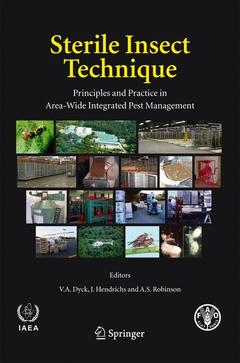Part I. Introduction. 1.1. History of the Sterile Insect Technique; W. Klassen, C.F. Curtis. Part II. Principles of the Sterile Insect Technique. 2.1. Area-Wide Integrated Pest Management and the Sterile Insect Technique; W. Klassen. 2.2. Biological Basis of the Sterile Insect Technique; D.R. Lance, D.O. McInnis. 2.3. Genetic Basis of the Sterile Insect Technique; A.S. Robinson. 2.4. Inherited Sterility in Insects; J.E. Carpenter et al. 2.5. Mathematical Models for the Use of Sterile Insects; H.J. Barclay. Part III. Technical Components of the Sterile Insect Technique. 3.1. Role of Population and Behavioural Ecology in the Sterile Insect Technique; Y. Itô,K. Yamamura. 3.2. Mass-Rearing for Sterile Insect Release; A.G. Parker. 3.3. Sterilizing Insects with Ionizing Radiation; A. Bakri et al. 3.4. Sterile Insect Quality; C.O. Calkins, A.G. Parker. 3.5. Sterile Insect Supply, Emergence, and Release; R.V. Dowell et al. 3.6. Monitoring Sterile and Wild Insects in Area-Wide Integrated Pest Management Programmes; M.J.B. Vreysen. 3.7. Procedures for Declaring Pest Free Status; H.J. Barclay et al. Part IV. Supportive Technologies to improve the Sterile Insect Technique. 4.1. Role of Population Genetics in the Sterile Insect Technique; E.S. Krafsur. 4.2. Population Suppression in Support of the Sterile Insect Technique; R.L. Mangan. 4.3. Genetic Sexing Strains in Mediterranean Fruit Fly, an Example for Other Species Amenable to Large-Scale Rearing for the Sterile Insect Technique; G. Franz. 4.4. Use of Geographic Information Systems and Spatial Analysis in Area-Wide Integrated Pest Management Programmes that Integrate the Sterile Insect Technique; J.St.H. Cox, M.J.B. Vreysen. PartV. Economic, Environmental, and Management Considerations. 5.1. Application of Benefit/Cost Analysis to Insect Pest Control Using the Sterile Insect Technique; J.D. Mumford. 5.2. Environment and the Sterile Insect Technique; P. Nagel, R. Peveling. 5.3. Management of Area-Wide Integrated Pest Management Programmes that Integrate the Sterile Insect Technique; V.A. Dyck et al. 5.4. Public Relations and Political Support in Area-Wide Integrated Pest Management Programmes that Integrate the Sterile Insect Technique; V.A. Dyck et al. Part VI. Application of the Sterile Insect Technique. 6.1. Strategic Options in Using Sterile Insects for Area-Wide Integrated Pest Management; J. Hendrichs et al. 6.2. Misconceptions and Constraints; M. Whitten, R. Mahon. Part VII. Impact of Area-Wide Integrated Pest Management Programmes that integrate the Sterile Insect Technique. 7.1. Impact of Screwworm Eradication Programmes Using the Sterile Insect Technique; M. Vargas-Terán et al. 7.2. Impact of Fruit Fly Control Programmes Using the Sterile Insect Technique; W.R. Enkerlin. 7.3. Impact of Moth Suppression/Eradication Programmes Using the Sterile Insect Technique or Inherited Sterility; K.A. Bloem et al. 7.4. Potential Impact of Tsetse Fly Control Involving the Sterile Insect Technique; U. Feldmann et al. Part VIII. Future Development of the Sterile Insect Technique. 8.1. Prospects for the Future Development and Application of the Sterile Insect Technique; A.S. Robinson, J. Hendrichs. Author index. Subject Index.




